The Walking Classroom
In a new two-part article for MiddleWeb, New Jersey teacher Mary Tarashuk offers a rich description of how she’s adapted a clever teaching strategy called The Walking Classroom, developed by a colleague in Chapel Hill, North Carolina. In the midst of writing and editing this story, Mary’s town of Westfield, NJ found itself directly in the path of Superstorm Sandy. After nine days out of school, power and water are restored and we’re pleased to bring you Part 1 of Mary’s walkabout with her students. Read Part 2 here.
by Mary C. Tarashuk
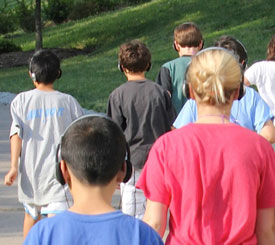
Fresh air and physical activity release us from the stale atmosphere that often settles into our classroom. And my students aren’t the only beneficiaries. I too am revived by a trip outside during the school day. It’s a win-win for all of us.
I constantly look for ways to teach a lesson outside, but at times it’s difficult to cover the curriculum without the use of my indoor resources: my chart paper, interactive blackboard, access to the internet, maps and art supplies. Then there are the mathematics, language, social studies, science, and technology benchmarks to meet in our broadening curriculum. As a result, the benefits of fresh air have to be balanced with time inside, learning the tools of readin’ and writin’ and ‘rithmatic.
So I was thrilled when I heard about a new program that is designed to get kids out of the building and into the sunshine.
The Walking Classroom
A woman whom I’d met years ago — during my first year as a teacher — had come up with an innovative idea that would help me strike a better balance between two learning spaces — inside and outside.

Thankfully, Laura and I had the technology to connect with each other, and eventually a large cardboard box was delivered to my school. The return address was Chapel Hill, and the logo on the label was easily recognizable because of its thoughtful and clever design.
I must admit that I giggled with glee as I scurried to my classroom with it, placed it on an empty desktop, grabbed a pair of scissors to cut through the heavy tape, and opened the box. There it was, the entire program delivered to my classroom, hot off the presses. I must admit, I didn’t read through the entire teachers’ guide right then. I was too excited. I immediately dug in and grabbed one of the WalkKits that was tucked in with the rest of our class set of listening devices.
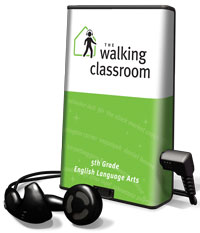
When I was able to get out of my kid persona and put on my pedagogical cap again, I lifted the large, green binder from the box. It held the lesson materials and background information for the teacher. The simple directions for introducing the program were a relief. I do well with straight-forward directions and suggested teaching tips. I was officially ready to give this a try.
My principal was very supportive. When I’d explained the idea to him, he’d given me the green light. By the twinkle in his eye, I knew his interest was peaked as well. It was time to see how the kids would respond.
Cardiovascular curriculum
We jumped right in, beginning with a look at heart rate, aerobic activity, cardio and cognitive function. It was important to me to let my kids know that we were getting more than just a chance to go outside. We were being given an opportunity to learn about interesting people and places while getting some exercise. I wanted to instill in them an understanding that we could all benefit from being active, especially in a world where technology allows us to be so deskbound, so often.
We learned how to take our pulses. Then we found our individual heart rates while they were at rest. Each child focused intently on locating his or her pulse. Immediately after mastering the art of finding our pulses and getting a baseline reading, we jumped around like maniacs, doing jumping jacks and outlandish dance moves for exactly one minute. As I screamed, “Stop!” twenty sets of fingers flew to their necks or wrists, as they prepared to collect data on our heart rates in action.
It made for giggles and an excellent review of statistical landmarks (those math standards won’t wait!). We identified the maximum, minimum, range, median, and mode of our beat-per-minute data. We calculated the mean of our class findings, and discovered that the terms mean and average are essentially synonymous. All well and good, but the kids were itching to start the “outside part” of the new program.
Getting outside
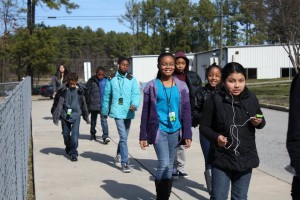
“Tomorrow,” I promised as the groans echoed in the room. They were soon replaced by smiles when I continued, “Today we walk without the WalkKits, so we can figure out our pace. We also need to observe anything going on outside that could distract us from our mission of power walking and learning cool stuff at the same time. If we are prepared for possible distractions, our first official walk tomorrow will go off without a hitch.”
“Yeah!” and “”Yessss!” mixed with hands shooting in the air, volunteering to be the pace car or the caboose on our first practice walk. These coveted positions are explained in detail in the teacher guide, but suffice it to say, they keep everyone together and accounted for while we are on our adventures.
Learning step by step
Our first official walk was a smashing success. The first audio lesson explains the logic behind the program and encourages kids to be more conscious of the food choices they make. It doesn’t vilify junk food, but it points out the scientific connections between good nutrition and healthy bodies. The podcast keeps it light, but the message is there.
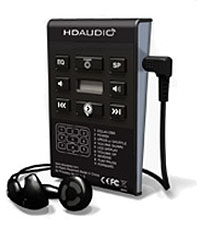
I have to say, the kids fell into the routine with ease. We had a set walking regiment in place almost immediately. It has been easy to dive into the many topics we’ve engaged so far, as we go on our bi-weekly walks. Truth be told, I would love to do it every day, but it is currently being used to supplement a curriculum that is already established by my school district. I will say that it accents this curriculum beautifully!
Scientific research shows that increased cardio function increases cognitive function. When our brains are full of oxygen, we learn with a fresh head. The Walking Classroom program seems especially effective for my kids who have attention issues, but I find that it benefits virtually every one of my students. They all seem to prefer to move while they learn. Me too.
Next time: Mary tells us more about The Walking Classroom learning experience, how she integrates the TWC content with her existing curriculum and lesson plans, and how her students seem to be learning more about curriculum content AND good health by hitting the road twice a week. Read Part 2.
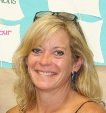






























We know readers will be curious about costs associated with The Walking Classroom. You can read more about the possibility of sponsored classroom sets at the FAQs page on the TWC Institute website. TWC is a non-profit organization.